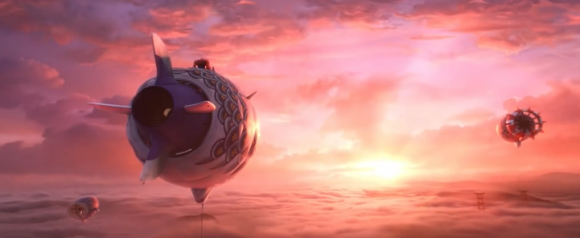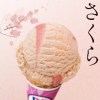While people in Japan put up decorations to celebrate different holidays, most of them are placed inside the home, such as the dolls for Girls’ Day/Hina Matsuri in March or the vegetables displayed during Obon in the summer. Out in public, though, though, you’d be hard-pressed to tell one Japanese holiday from another, with the exception of Children’s Day/Kodomo no Hi on May 5.
That’s because when Children’s Day rolls around, all you have to do is look up at all of the beautifully awesome carp streamers flying overhead,
Children’s Day used to be known as Boys’ Day, and families with sons would fly a carp streamer (koinobori in Japanese) for each of their male children above their home. As the cloth caught the breeze, it would writhe back and forth, looking like it was valiantly swimming upstream, which was taken as a symbol showing that the family’s young men would grow up to be similarly strong and brave.
Since May 5 became officially renamed Children’s Day, some families have begun flying carp streamers for their daughters as well, although the practice is still much more widespread in families with boys. What hasn’t changed, though, is how cool they look.
https://twitter.com/wasabitool/status/594989684100476928While many families still fly their koinobori individually from the roofs or balconies of their own homes, in some communities they’re displayed en masse, often strung over a river.
吹く風爽やか
— 時計草 (@tokeisou88) April 30, 2015
材木岩(宮城県白石市)の鯉のぼり pic.twitter.com/eDOQfzLNbV
皆さん、お早うございますヽ(´∀`。)ノ
— よっちゃん (@utamarukousa) April 30, 2015
早いもので風薫る5月に成りました。
今月も楽しいお付き合いを宜しくお願いします☆
では、楽しいゴールデンウイークを٩(๑′∀ ‵๑)۶•*¨*•.¸¸♪❤
行って来まーす♪#鯉のぼり pic.twitter.com/qSiT5ftKhW
While this practice is most common in rural areas, you can sometimes spot it in more developed areas as well.
【恋のぼり】
— hiroro (@hika_ri1020) May 2, 2015
五月晴れの気持ちいい午後
川を泳ぐ鯉のぼり
私の気持ちもあなたの心に
たどりつけますように…
大人の日もあったらいいのにね…
素敵な休日をお過ごしください
*⑅ ⋆♡*⑅ ⋆♡*⑅ ⋆♡*⑅ ⋆♡*⑅ ⋆ pic.twitter.com/c1gRLgM350
「鯉のぼりすぎ」
— ふぁぼぴく@きょうすけ (@kyousukeimg) May 2, 2015
☆大阪府高槻市/芥川桜堤公園#写真好きな人と繋がりたい pic.twitter.com/sTcbdK6LsA
Of course, if you’re living in the concrete jungle of urban Japan, you might not have a river nearby. That’s not an insurmountable problem, though, as shown in this video by expat and YouTube user BusanKevin who lives in an apartment complex that hangs its koinobori between the high-rises.
Sometimes, the koinobori are amassed in such a large school of fabric fish that they almost block out the sky.
https://twitter.com/TheZekkei/status/593265252491362304おはようございます。
— イルカ (@shonan_iruka) May 2, 2015
今日も「感謝」の気持ちと「ありがとう」が素直に言える一日。
そして、笑顔で過ごしましょう。
写真は、【鯉のぼり】→ pic.twitter.com/Ot32F416vW
▼ Even this dog got in on the carp streamer fun.
コロンたん、鯉のぼりの羽根が生えました😁 pic.twitter.com/Rn9vBZOtnn
— 白ポメラニアン コロンちゃん (@5577coron) May 2, 2015
▼ A rare case of color-coordinated koinobori
青い鯉のぼりプロジェクト。東松島市大曲浜地区では追悼の意味を込めて、毎年この時期に数百匹の青い鯉のぼりを揚げます。5日の昼にはこの下で演奏などのイベントも開かれます。https://t.co/FwLbRXeLoW pic.twitter.com/jg2zVT2WOX
— T. Suzuki (@jpnsuzuki) April 29, 2015
As a matter of fact, koinobori have such an established cultural legacy that they were even included in Disney’s Big Hero 6, albeit in mechanized form.
And of course, like any iconic image of Japan, they look especially cool with Mt. Fuji in the background.
【子供の日】
— イルカ (@shonan_iruka) May 4, 2015
おはようございます。
今日も「感謝」の気持ちと「ありがとう」が素直に言える一日。
そして、笑顔で過ごしましょう。
写真は、【富士山・鯉のぼり】→ pic.twitter.com/XjdW8MJxPr
See you again next year, koinobori!
Source: Kaigai Matome.net
Insert image: YouTube


 KFC’s Colonel Sanders is becoming a samurai in Japan this week
KFC’s Colonel Sanders is becoming a samurai in Japan this week Japanese adult acts as perfect train driver using just a children’s picture book 【Video】
Japanese adult acts as perfect train driver using just a children’s picture book 【Video】 Maid Day 2019 brings out Japan’s best maid cosplayers【Photos】
Maid Day 2019 brings out Japan’s best maid cosplayers【Photos】 That time Seiji called JASRAC to ask why he didn’t get paid royalties for his song being on TV
That time Seiji called JASRAC to ask why he didn’t get paid royalties for his song being on TV Urusei Yatsura anime remake’s first preview video looks good, sounds even better, reveals premier
Urusei Yatsura anime remake’s first preview video looks good, sounds even better, reveals premier Hayao Miyazaki says Happy New Year to Studio Ghibli fans with new art for Year of the Horse
Hayao Miyazaki says Happy New Year to Studio Ghibli fans with new art for Year of the Horse We revisited Sweets Paradise after a decade to see if Japan’s dessert buffet still delivers
We revisited Sweets Paradise after a decade to see if Japan’s dessert buffet still delivers 7 great places to see Mt. Fuji from without having to climb it
7 great places to see Mt. Fuji from without having to climb it Sakura-flavored ice cream returns to Baskin Robbins in Japan after 24 years!
Sakura-flavored ice cream returns to Baskin Robbins in Japan after 24 years! Coca-Cola Japan releases new clear coke this month, we get to try it before it goes on sale
Coca-Cola Japan releases new clear coke this month, we get to try it before it goes on sale Cup Noodle releases new Tomica “car” collection
Cup Noodle releases new Tomica “car” collection We search for the fabled bed and breakfast inside Narita’s runway that’s just 10 bucks a night
We search for the fabled bed and breakfast inside Narita’s runway that’s just 10 bucks a night Foreign tourist in Japan arrested for having sex on shrine grounds in broad daylight
Foreign tourist in Japan arrested for having sex on shrine grounds in broad daylight Starbucks Japan ready to get Year of the Horse started with adorable drinkware and plushies【Pics】
Starbucks Japan ready to get Year of the Horse started with adorable drinkware and plushies【Pics】 Cyberpunk anime meets traditional culture in Ghost in the Shell gold leaf Japanese changing screens
Cyberpunk anime meets traditional culture in Ghost in the Shell gold leaf Japanese changing screens Hello Kitty Choco Egg figures are an adorable trip through three periods of Japanese pop culture【Pics】
Hello Kitty Choco Egg figures are an adorable trip through three periods of Japanese pop culture【Pics】 7-Eleven Japan’s ramen-cooking robot whipped us up a bowl of noodles【Taste test】
7-Eleven Japan’s ramen-cooking robot whipped us up a bowl of noodles【Taste test】 We found possibly the quietest Japanese-style hotel in Tokyo’s bustling Shinjuku district
We found possibly the quietest Japanese-style hotel in Tokyo’s bustling Shinjuku district Japan’s otoshidama tradition of giving kids money at New Year’s gets a social welfare upgrade
Japan’s otoshidama tradition of giving kids money at New Year’s gets a social welfare upgrade Sumo Sanrio! Hello Kitty and pals team up with Japan Sumo Association for new merch【Pics】
Sumo Sanrio! Hello Kitty and pals team up with Japan Sumo Association for new merch【Pics】 More Than a Capsule Stay: Why Solo Travelers Choose “global cabin Yokohama Chinatown”
More Than a Capsule Stay: Why Solo Travelers Choose “global cabin Yokohama Chinatown” Japan’s oldest largetooth sawfish in captivity back on display in Mie Prefecture
Japan’s oldest largetooth sawfish in captivity back on display in Mie Prefecture 7-Eleven Japan starts new temporary luggage storage service in over 300 branches
7-Eleven Japan starts new temporary luggage storage service in over 300 branches Disillusionment at Tsukiji’s tourist-target prices led us to a great ramen restaurant in Tokyo
Disillusionment at Tsukiji’s tourist-target prices led us to a great ramen restaurant in Tokyo Starbucks teams up with 166-year-old Kyoto doll maker for Year of the Horse decorations【Photos】
Starbucks teams up with 166-year-old Kyoto doll maker for Year of the Horse decorations【Photos】 Tokyo considering law requiring more trash cans following litter increase in heavily touristed area
Tokyo considering law requiring more trash cans following litter increase in heavily touristed area Tokyo’s Tsukiji sushi neighborhood asks tour groups to stay away for the rest of the month
Tokyo’s Tsukiji sushi neighborhood asks tour groups to stay away for the rest of the month Tokyo event lets you travel back in time, for free, to celebrate 100 years since Showa era start
Tokyo event lets you travel back in time, for free, to celebrate 100 years since Showa era start Sanrio theme park in Japan announces plans to expand into a Sanrio resort
Sanrio theme park in Japan announces plans to expand into a Sanrio resort Japan may add Japanese language proficiency, lifestyle classes to permanent foreign resident requirements
Japan may add Japanese language proficiency, lifestyle classes to permanent foreign resident requirements Stamina-destroying “Paralysis Noodles” are Tokyo’s newest over-the-top ramen innovation
Stamina-destroying “Paralysis Noodles” are Tokyo’s newest over-the-top ramen innovation Survey asks foreign tourists what bothered them in Japan, more than half gave same answer
Survey asks foreign tourists what bothered them in Japan, more than half gave same answer Japan’s human washing machines will go on sale to general public, demos to be held in Tokyo
Japan’s human washing machines will go on sale to general public, demos to be held in Tokyo Japan’s deadliest food claims more victims, but why do people keep eating it for New Year’s?
Japan’s deadliest food claims more victims, but why do people keep eating it for New Year’s? We deeply regret going into this tunnel on our walk in the mountains of Japan
We deeply regret going into this tunnel on our walk in the mountains of Japan Studio Ghibli releases Kodama forest spirits from Princess Mononoke to light up your home
Studio Ghibli releases Kodama forest spirits from Princess Mononoke to light up your home Major Japanese hotel chain says reservations via overseas booking sites may not be valid
Major Japanese hotel chain says reservations via overseas booking sites may not be valid Put sesame oil in your coffee? Japanese maker says it’s the best way to start your day【Taste test】
Put sesame oil in your coffee? Japanese maker says it’s the best way to start your day【Taste test】 No more using real katana for tourism activities, Japan’s National Police Agency says
No more using real katana for tourism activities, Japan’s National Police Agency says Starbucks Japan reveals new sakura drinkware collection, inspired by evening cherry blossoms
Starbucks Japan reveals new sakura drinkware collection, inspired by evening cherry blossoms Updated cherry blossom forecast shows extra-long sakura season for Japan this year
Updated cherry blossom forecast shows extra-long sakura season for Japan this year Beautiful photos of the isekai-looking mountain that’s one of the Tokyo area’s best day-trips
Beautiful photos of the isekai-looking mountain that’s one of the Tokyo area’s best day-trips Japan’s new ukiyo-e woodblock print passports are beautiful, now in travelers’ hands【Photos】
Japan’s new ukiyo-e woodblock print passports are beautiful, now in travelers’ hands【Photos】 Japanese origami vending machine makes news around the country
Japanese origami vending machine makes news around the country Mt. Fuji schoolgirl photo models who charmed Japan years ago reunite to celebrate Coming of Age Day
Mt. Fuji schoolgirl photo models who charmed Japan years ago reunite to celebrate Coming of Age Day Tokyo’s Akihabara looks otherworldly beautiful when all the people are gone【Photos】
Tokyo’s Akihabara looks otherworldly beautiful when all the people are gone【Photos】 A parade of Sanrio characters celebrate Cat Day over Twitter with cat ears and more
A parade of Sanrio characters celebrate Cat Day over Twitter with cat ears and more Cosplayers and models share selfies to celebrate Bikini Day in Japan
Cosplayers and models share selfies to celebrate Bikini Day in Japan Beautiful Japanese cake looks like a slice of the ocean frozen in time【Photos】
Beautiful Japanese cake looks like a slice of the ocean frozen in time【Photos】 Eevee Day now officially recognized in Japan as a day to celebrate the cute furry Pokémon
Eevee Day now officially recognized in Japan as a day to celebrate the cute furry Pokémon The 10 best castles in Japan, as chosen by experts and fans
The 10 best castles in Japan, as chosen by experts and fans Demon Slayer: Kimetsu no Yaiba desserts are some of the most beautiful anime sweets ever【Photos】
Demon Slayer: Kimetsu no Yaiba desserts are some of the most beautiful anime sweets ever【Photos】
Leave a Reply